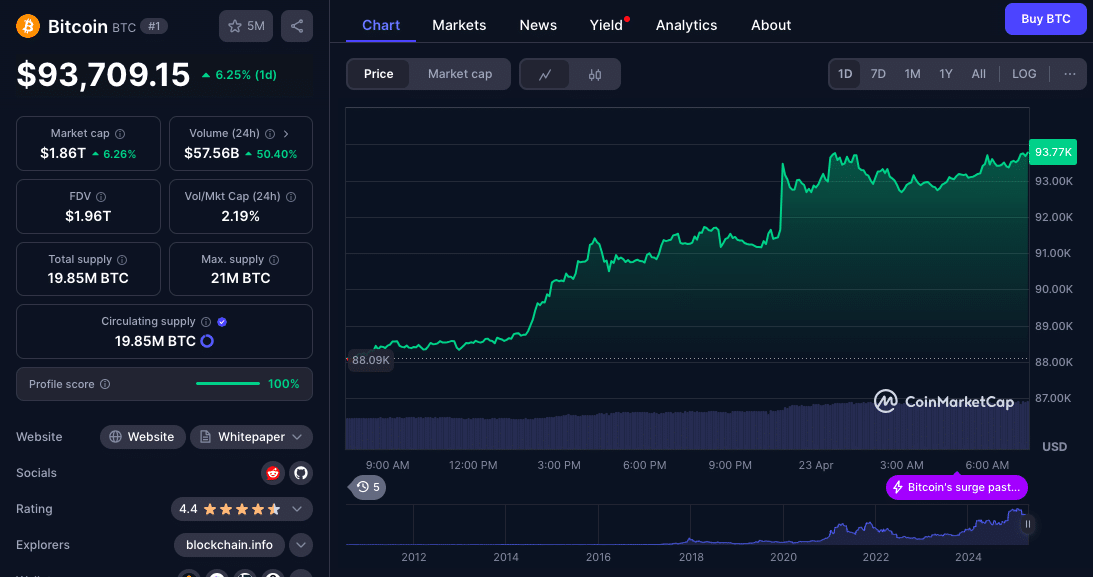Bitcoin broke through $93,000 Tuesday afternoon, its highest level since March, as geopolitical relief and demand surged. This was triggered by back-to-back statements from top US officials saying they’re softening on trade tariffs with China. While the short-term market reaction was positive, on-chain data and ETF flows show cracks beneath the surface that may cap further upside.
Washington Signals Trade De-escalation, Markets React
Bitcoin’s move came after Treasury Secretary Scott Bessent reportedly told institutional investors at a JPMorgan event that the US and China tariff trade war is “unsustainable” and will “de-escalate very soon” according to multiple attendees. He described the current situation as a “trade embargo”.
Hours later, it was reported that President Trump confirmed the administration’s direction, saying US tariffs on Chinese goods (currently 145%) “will come down substantially”. He also said he has no plans to fire Fed Chair Jerome Powell despite pressure to lower rates.
The combined statements sent markets into risk-on mode. Bitcoin was already up and hit a session high of $93,400. At press time, Bitcoin stands at $93,709.

Altcoins Follow Bitcoin’s Lead in Synchronized Surge
Ethereum (ETH) rose 8% to above $1,700. Memecoin favorite Dogecoin (DOGE) rose 8.6% and layer-1 upstart Sui (SUI) went up by 11.7%. The broader crypto indices rose 5.2% over the same period.
Traditional markets joined the party. The S&P 500 and Nasdaq rose 2.5% and 2.7%, respectively. Gold, which hit a record $3,500 earlier in the day, closed 1% lower as capital rotated into risk and inflation hedges.
Institutional Activity Picks Up, But Liquidity Lags
QCP Capital noted the return of the “Coinbase premium”, a sign of US institutional demand. They also pointed to growing capital flowing into US-listed spot Bitcoin ETFs. Farside Investors reported $381 million in net inflows on Monday and $107 million the previous Thursday.
“BTC and gold are the beneficiaries of the USD risk unwind,” QCP wrote in a Telegram update, saying the latest move was due to capital fleeing inflation-exposed assets.
However, analysts warned of liquidity concerns. USDT, the proxy for market liquidity, only grew $2.9 billion in the last two months, below the $5 billion growth seen during strong BTC rallies. Speculations are that this could cap the upside.
According to a post on X (formerly Twitter), this current BTC move is a “classical FOMO behaviour”.

CryptoQuant Flags Resistance and Weak Demand Momentum
Despite the good news, CryptoQuant says analysts are getting cautious. A Tuesday report showed that Bitcoin’s demand dropped by 146,000 BTC over the last 30 days. That is an improvement from March but still negative.
Additionally, CryptoQuant’s demand momentum metric is at its most bearish since October 2024. The firm also notes that Bitcoin is facing resistance between $91,000 and $92,000, calling it the “Trader’s On-chain Realized Price” level, which has been a barrier during bearish times.
“The on-chain bull score is bearish,” CryptoQuant says. “Sentiment needs to improve materially to break above this resistance and hold gains.”
Analysis: A Bullish Move with Fragile Foundations
While Bitcoin’s move above $93K is strong short-term and reflects confidence triggered by geopolitical clarity, it’s still in tough terrain. Liquidity is low, demand is weak and technical resistance will likely stall price action.
A real breakout will require more economic policy clarity, sustained ETF inflows and on-chain activity. Until then the crypto market will likely oscillate within this range and be vulnerable to macro headlines and sentiment shifts.
Conclusion
Bitcoin’s move above $93,000 is a big deal in 2025 and was triggered by US and China tariff optimism and capital flows. But as with previous crypto rallies built on external catalysts, sustainability is uncertain without stronger market fundamentals. Investors should watch geopolitics and on-chain data in the coming days.
FAQs
What caused Bitcoin to go above $93K?
Bitcoin went up due to the US and China trade tariff talks. Treasury Secretary Bessent and President Trump said tariffs will be reduced soon, and risk appetite will increase.
Are altcoins following Bitcoin?
Yes, altcoins like Ethereum (ETH), Dogecoin (DOGE) and Sui (SUI) also went up big time, reflecting broader ‘crypto market demand.
What are analysts saying about market stability?
Despite the price move, analysts are warning of underlying weakness. CryptoQuant says demand is down and liquidity is low, so this rally may not be sustainable.
Is institutional money coming back to crypto?
Yes, QCP Capital and Farside Investors say spot BTC ETFs are seeing inflows and US institutions are interested again, as reflected by the Coinbase premium.
What’s stopping Bitcoin from going higher?
Resistance at $91K–$92K, weak demand momentum and low liquidity.
Glossary
Bitcoin (BTC): The first and largest cryptocurrency by market cap, a decentralized and deflationary asset.
Altcoin: Any cryptocurrency other than Bitcoin.
Coinbase Premium: The price difference between BTC on Coinbase and other exchanges is a proxy for US demand.
On-chain Data: Data derived from blockchain activity, used to measure investor behavior and sentiment.
USDT (Tether): A stablecoin pegged to the US dollar, used to measure crypto market liquidity.



















































































































